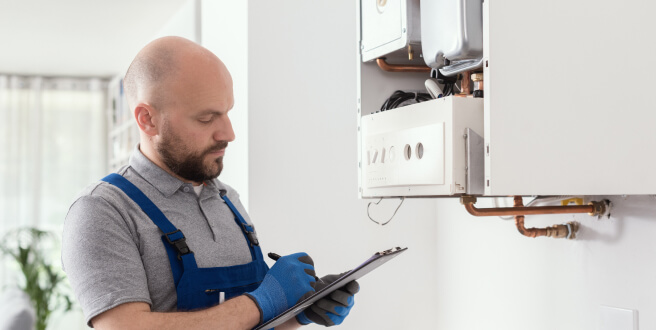
Fixed price boiler installation
Save up to £585 per year by replacing your boiler! For just £22 a month with no deposit and a 10 year warranty.
Learn more
Boiler cover
Keep your existing boiler covered with 24/7 support from just £19.99 a month.
Learn moreWhat happens to my energy supply when I move house?
During any average month in the UK, 100,000 households will move house, each confronting a checklist of chores that range from boxing up all their possessions to updating their address to sorting out their utilities.
As soon as you move in the lights will turn on, the boiler will heat water and rooms, but be cautious because you could be paying well over the odds for this gas and electricity.
To avoid unnecessary charges on your energy bills during a time already filled with additional expenses, from security deposits to moving services, follow these essential steps to manage your energy supply and tariff when moving house.
In This Guide:
- Can I keep my current energy tariff when moving house?
- What do I need to do before I move?
- What you should do after moving
- FAQs
Can I keep my current energy tariff when moving house?
Some energy suppliers do let you transfer your fixed-rate deal to your new home, which can be a real bonus if you’re on a great rate or want to dodge exit fees. However, keep in mind that energy prices can differ depending on where you are in the UK. So, even if you can bring your tariff with you, the rate might change if you’re moving to a new area.
However, not all suppliers offer this flexibility, so it’s a good idea to get in touch with yours before you start packing - aim to do this at least 48 hours before your move to give yourself enough time to sort everything out.
Once you’re settled in, it’s a good idea to compare energy deals to see if you can find a cheaper plan. It’s a simple process and can save you a lot on your energy bills.
What do I need to do before I move?
Get in touch with your current supplier:
You're obligated to contact your current energy supplier at least 48 hours before your move, telling them the date of your move and your new address, so they can send you your final bill. If you're on a fixed energy tariff with a set end date, you may incur early termination fees for exiting it early. early' is typically defined as any time before 49 days prior to the stated expiry date, outside of the so-called switching window.'
Take a meter reading on the day you move and provide it to the supplier:
To avoid being overcharged by your energy supplier, or charged for any energy used by the next occupants of the home, take a meter reading on the day you vacate the property. Give it to your current energy supplier and also make note of it yourself, so you can refer back to it if disputes arise. If you're a renter, you should also pass along and confirm these meter readings with your landlord.
Tell future occupants about the current energy supplier:
As a courtesy to the next residents of your home, you may want to notify them of the current energy supplier of the property, which they will need to contact when they move in (as you will too on the other side of your move). You can leave a note for them or tell this information to your estate agent or, if you're a renter, your landlord.
What you should do after moving
Take a meter reading:
To ensure you're only charged for your own energy consumption and not that of previous tenants, one of your first steps upon moving into a property-at least before you run a bath in your new tub and fire up the Aga to make dinner-should be to take a meter reading. Note down the current readings for both electricity and gas. You'll need to provide these to the current supplier of the property.
Find out the current supplier of the property:
Maybe you'll get lucky and the previous residents of the home will be as helpful as you were at your last address and will have left you a note telling you who supplies the property's electricity, gas, or both, or conveyed that information to the estate agent or landlord.
If you're moved into a new-build property, the developer should hold this information. But if no help is forthcoming, follow these steps to determine a property's energy supplier(s):
Electricity: Call your regional electricity distribution company and ask for the meter point administration service (MPAS). They have access to the Electricity Central Online Enquiry Service (ECOES), a database listing the electricity supplier of every address in the UK. Give them your address and they'll be able to tell you its current electricity supplier.
Gas: Call the Meter Number Helpline on 0870 608 1524 and provide them with your Meter Point Reference Number (MPRN), a unique six- to 10-digit supply reference code you should be able to find on your gas meter. If you're having difficulty locating this number, the Meter Number Helpline should be able to guide you to it. Once they have this code, they'll be able to tell you the property's current gas supplier.
Get in contact with the current supplier:
You'll need to give that move-in day meter reading to the property's current supplier. They'll eventually send you a bill for any energy you've use. Note that if you're purchased the property, you'll be responsible for any energy consumed since the date you assumed ownership of it, whether or not that's when you moved in. Although the property may be vacant before you move in and not using energy, you'll still be incurring a standing charge for the supply.
Compare energy and switch for savings:
When you first move into a property, you’ll be placed on a 'deemed tariff' with the current energy supplier, which is a default rate you didn’t choose. These tariffs are usually more expensive than the deal you had before, especially if you were on a fixed-rate tariff. It’s a good idea to switch energy suppliers once you’re settled in and compare energy deals to find the best options available in your new postcode. Don’t just stick with your old supplier out of habit, as their rates might differ in your new area or could be bettered by another provider.
Research shows that shopping around and switching energy providers can save households over £300 annually. Use your move as an opportunity to secure the best energy deal for your needs.
Switching your energy supplier after moving is easy, just head over to our gas and electricity price comparison page, or enter your postcode at the top of this page, and see how much you could save.
FAQs
Can I switch gas and electricity suppliers if I'm renting?
If you’ve moved into a rented property, your tenancy agreement should outline how the energy supply is managed and paid for. You’ll either be responsible for setting up and paying for the supply yourself, or your landlord will handle it and either include the cost in your rent or bill you separately.
If you are responsible for the energy supply, you can switch suppliers at any time without needing your landlord’s approval. However, it’s courteous to inform them of the switch so they can provide accurate information about the supply to future tenants. If your landlord manages and pays for the property’s energy, you can request a switch to a new energy supplier, but they are not required to agree.
Can I install a smart meter in my new home?
Yes, you can install a smart meter in your new home, and it’s often a straightforward process. Smart meters offer several benefits, including accurate real-time tracking of your energy usage and eliminating the need for manual meter readings.
If you own your new home, you can contact your energy supplier to arrange the installation of a smart meter. Most suppliers are keen to upgrade customers to smart meters and may offer the installation at no extra cost. It’s a good idea to check if your supplier has any specific installation schedules or requirements.
For renters, the process is also relatively simple, but there are a few extra considerations. You typically have the right to request a smart meter from your energy supplier, even if you’re renting. However, it’s courteous and often advisable to inform your landlord of your intention to install one, as they might need to be involved in the process, especially if modifications to the property are required.
My new home has a prepayment meter, can I change it?
If your new home has a prepayment meter, your estate agent or landlord should give you a key or card to top it up. You can also request a new key or card from the energy supplier. Prepayment meters are helpful for budgeting but tend to be more expensive. It’s advisable to contact your energy supplier to switch to a standard credit meter or a smart meter, as paying by Direct Debit is usually cheaper. If you’re renting, you can change the meter without your landlord’s permission, though they may ask you to revert it to a prepayment meter when you move out.
Do I take my smart meter with me when I move?
No, you don’t take your smart meter with you when you move. Smart meters are installed as permanent fixtures in homes, so they stay with the property.
How long does it take to switch energy supplier?
Switching energy suppliers typically takes about 21 days, including a mandatory 14-day cooling-off period during which you can cancel the switch without any penalty.
Do I have to pay to switch supplier?
Generally, switching energy suppliers is free, as most suppliers do not charge a switching fee. However, if you are on a fixed-term contract, you might incur an early exit fee for leaving before the contract ends. It’s important to check your contract terms to see if this fee applies. For those on standard variable tariffs, there are typically no exit fees, allowing you to switch without any additional costs. Some suppliers may also offer promotions that cover any exit fees from your previous contract, making the switch even more cost-effective. Switching suppliers is usually a simple and economical way to reduce your energy bills, but always review your current contract to understand any potential charges.




